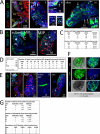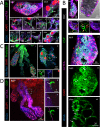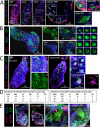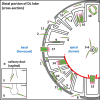Anopheles Salivary Gland Architecture Shapes Plasmodium Sporozoite Availability for Transmission
- PMID: 31387905
- PMCID: PMC6686039
- DOI: 10.1128/mBio.01238-19
Anopheles Salivary Gland Architecture Shapes Plasmodium Sporozoite Availability for Transmission
Abstract
Plasmodium sporozoites (SPZs) must traverse the mosquito salivary glands (SGs) to reach a new vertebrate host and continue the malaria disease cycle. Although SGs can harbor thousands of sporozoites, only 10 to 100 are deposited into a host during probing. To determine how the SGs might function as a bottleneck in SPZ transmission, we have characterized Anopheles stephensi SGs infected with the rodent malaria parasite Plasmodium berghei using immunofluorescence confocal microscopy. Our analyses corroborate findings from previous electron microscopy studies and provide new insights into the invasion process. We identified sites of SPZ accumulation within SGs across a range of infection intensities. Although SPZs were most often seen in the distal lateral SG lobes, they were also observed in the medial and proximal lateral lobes. Most parasites were associated with either the basement membrane or secretory cavities. SPZs accumulated at physical barriers, including fused salivary ducts and extensions of the chitinous salivary duct wall into the distal lumen. SPZs were observed only rarely within salivary ducts. SPZs appeared to contact each other in many different quantities, not just in the previously described large bundles. Within parasite bundles, all of the SPZs were oriented in the same direction. We found that moderate levels of infection did not necessarily correlate with major SG disruptions or abundant SG cell death. Altogether, our findings suggest that SG architecture largely acts as a barrier to SPZ transmission.IMPORTANCE Malaria continues to have a devastating impact on human health. With growing resistance to insecticides and antimalarial drugs, as well as climate change predictions indicating expansion of vector territories, the impact of malaria is likely to increase. Additional insights regarding pathogen migration through vector mosquitoes are needed to develop novel methods to prevent transmission to new hosts. Pathogens, including the microbes that cause malaria, must invade the salivary glands (SGs) for transmission. Since SG traversal is required for parasite transmission, SGs are ideal targets for transmission-blocking strategies. The work presented here highlights the role that mosquito SG architecture plays in limiting parasite traversal, revealing how the SG transmission bottleneck is imposed. Further, our data provide unprecedented detail about SG-sporozoite interactions and gland-to-gland variation not provided in previous studies.
Keywords: malaria; mosquito; salivary gland; sporozoite.
Copyright © 2019 Wells and Andrew.
Figures







Similar articles
-
Imaging movement of malaria parasites during transmission by Anopheles mosquitoes.Cell Microbiol. 2004 Jul;6(7):687-94. doi: 10.1111/j.1462-5822.2004.00395.x. Cell Microbiol. 2004. PMID: 15186404
-
The influence of oviposition status on measures of transmission potential in malaria-infected mosquitoes depends on sugar availability.Parasit Vectors. 2024 May 23;17(1):236. doi: 10.1186/s13071-024-06317-2. Parasit Vectors. 2024. PMID: 38783366 Free PMC article.
-
Immunomodulation by Mosquito Salivary Protein AgSAP Contributes to Early Host Infection by Plasmodium.mBio. 2021 Dec 21;12(6):e0309121. doi: 10.1128/mBio.03091-21. Epub 2021 Dec 14. mBio. 2021. PMID: 34903042 Free PMC article.
-
When Is a Plasmodium-Infected Mosquito an Infectious Mosquito?Trends Parasitol. 2020 Aug;36(8):705-716. doi: 10.1016/j.pt.2020.05.011. Epub 2020 Jul 1. Trends Parasitol. 2020. PMID: 32620501 Free PMC article. Review.
-
Malaria: influence of Anopheles mosquito saliva on Plasmodium infection.Trends Immunol. 2023 Apr;44(4):256-265. doi: 10.1016/j.it.2023.02.005. Epub 2023 Mar 22. Trends Immunol. 2023. PMID: 36964020 Free PMC article. Review.
Cited by
-
Effective Oral RNA Interference (RNAi) Administration to Adult Anopheles gambiae Mosquitoes.J Vis Exp. 2022 Mar 1;(181):10.3791/63266. doi: 10.3791/63266. J Vis Exp. 2022. PMID: 35311819 Free PMC article.
-
Aedes aegypti SGS1 is critical for Plasmodium gallinaceum infection of both the mosquito midgut and salivary glands.Malar J. 2021 Jan 6;20(1):11. doi: 10.1186/s12936-020-03537-6. Malar J. 2021. PMID: 33407511 Free PMC article.
-
The salivary protein Saglin facilitates efficient midgut colonization of Anopheles mosquitoes by malaria parasites.PLoS Pathog. 2023 Mar 2;19(3):e1010538. doi: 10.1371/journal.ppat.1010538. eCollection 2023 Mar. PLoS Pathog. 2023. PMID: 36862755 Free PMC article.
-
Performing Immunohistochemistry in Mosquito Salivary Glands.Cold Spring Harb Protoc. 2022 Oct 3;2022(10):Pdb.top107699. doi: 10.1101/pdb.top107699. Cold Spring Harb Protoc. 2022. PMID: 35960615 Free PMC article.
-
A Simple Method for Immunohistochemistry and Imaging of Mosquito Salivary Glands.Cold Spring Harb Protoc. 2022 Oct 3;2022(10):Pdb.prot107990. doi: 10.1101/pdb.prot107990. Cold Spring Harb Protoc. 2022. PMID: 35960629 Free PMC article.
References
-
- World Health Organization. 2017. World malaria report 2017. World Health Organization, Geneva, Switzerland.
Publication types
MeSH terms
Grants and funding
LinkOut - more resources
Full Text Sources
Medical
